Latest News
March 1, 2013
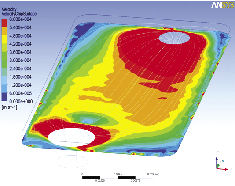 In one of its consulting projects, Ozen analyzes the optimization of a fluid passing through a flow cell where the properties of the fluid are being measured on the sensor surface. To obtain accurate measurements, the fluid should have a uniform velocity. |
Tom Marinaccio tends to get distress calls from people trying to understand why something has failed, usually with the need to find an answer and fix it in a narrow window of time. He describes a typical call as follows: “]The plant operator] had some ideas what the problem was. The material that forms the thermal protection inside a furnace seemed to be eroding more quickly than expected. They had several plants. They operated them the same way. But at that particular one, they were getting warning signs. The outside of the furnace was hotter than it should be. They knew something had gone wrong inside, but didn’t know what.”
The facility owners knew they needed to shut down to implement a permanent fix, but the downtime must be kept to an absolute minimum. It would be up to Marinaccio and his colleagues to digitally simulate the operations of the troubled furnace, complete with material properties and thermal loads, and then present the most probable answer to the owners.
With sophisticated CAE software, Marinaccio could literally show a cross-section of the furnace to reveal the heat buildup inside. This new understanding gave plant operators confidence in the remedy they had chosen. If necessary, Marinaccio could also simulate the planned fix to predict whether it would work.
Metin Ozen has received similar calls. He remembers the time Keck Observatory in Hawaii reached out to him. “It’s up at 14,000 ft. At that elevation, the ambient air gets very cold at night,” he says. “When they open up the observatory, there’s a sudden change in temperature in the mirror. It’s made of glass, but supported by structures with another material, so they expand at different rates. We were called in because the mirror started cracking.”
Cory Huey tends to get a different variety of Mayday calls—usually from manufacturers who have come to realize they’re lagging behind their competition because of aging IT and software infrastructure. They want to undertake a technology upgrade, accompanied by a workflow overhaul, but aren’t sure where or how to begin. EAC, Huey’s employer, has been involved with more than 400 product lifecycle management (PLM) system implementations, just in the last six years. And that historical knowledge, Huey adds, “can get a customer to the point of success faster than they can on their own.”
Marinaccio, senior vice president of CD-adapco’s worldwide engineering services; Ozen, CEO of Ozen Engineering; and Huey, vice president of services at EAC, belong to a growing pool of hired guns for design and engineering projects. Simulation experts like Marinaccio and Ozen are ideal for projects where you need swift resolution and don’t want to deal with acquiring, learning and mastering a particular technology—for example, software-driven fluid or thermal simulation. Quite often, they won’t even need to haul their laptop and fly to the troubled site; they just need the CAD file, operating conditions, and a series of inputs to find the answer. PLM experts like Huey and his colleagues have implementation experience culled from years of continuous improvement of their engagement process. They’re your on-demand reinforcement, part of the consultant brigade to help you put out fires, deal with a sudden workload spike, or usher you into a more efficient workflow. For businesses that prefer to keep a lean in-house staff, engaging freelance talents has become a vital part of operations.
Specialized Skills, Software Mastery and Hardware Firepower
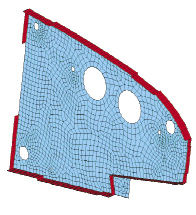 The meshed topology of a wing section of Airbus 380, part of a consulting project undertaken by Altair ProjectDesign Group. |
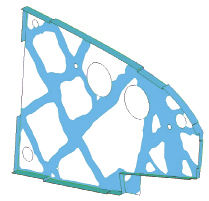 The optimal topology, as proposed by Altairs OptiStruct. |
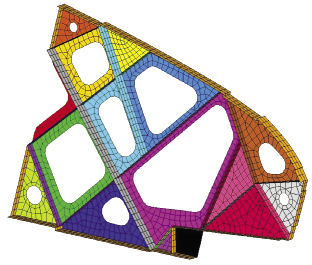 The final design proposed by Altair ProductDesign Group, which makes the wing 40% lighter. |
Most simulation consultants have a specialty, encompassing a deep understanding of the best practices, government regulations and software tools used in their domains. From past history and repeated consultation, they have developed encyclopedic knowledge of specific areas, such as sustainability, thermal conductivity, air flow, fluid flow, weight reduction, etc.
“Our specialty is solder-joint reliability,” Ozen says. “In many modern devices ]cellphones, tablets, etc.], the solder joints go through many cyclic motions. They are usually the weakest connection in electrical components. When you drop them, the solder joints are the first ones that usually fail.”
Lately, Ozen has expanded its services into electro-migration analysis, a prevalent phenomenon in cell phones, CPUs and LED units. “It’s a different failure mechanism. Materials tend to evaporate, dissipate. This happens because of the high current in tiny electronic devices,” he explains.
Ozen uses ANSYS Multiphysics (MP) and ANSYS Mechanical to simulate thermal stresses and coupled physics phenomena (like electro-migration or electrostatic on structures). “Some clients do have the software in-house, but don’t have the knowhow to set up the simulation problem correctly,” Ozen says. “So we would go in, show them how to set it up, solve it, hand the engineer a report—essentially train them to do an advanced simulation in-house. Then there are other clients, like a startup, that don’t have the money to invest in the software; they just want a problem solved.”
Consultants also make a point to augment their software arsenal with appropriate hardware. Part of the benefits a consultant offers is its ability to run compute-intense programs on its own systems without tying up the client’s resources. Last year, Ozen added a high-performance computing (HPC) server with 48 processors, custom-built by Fine Tec Computer. Ozen also acquired a HP Z820 workstation equipped with NVIDIA Maximus technology, comprised of two GPUs (Quadro and Tesla units). Because ANSYS software is written to run parallel computing jobs on multicore CPUs and GPUs, newer hardware dramatically speeds up processing time: “We can now solve in a day or two projects that used to take one or two weeks,” Ozen says.
It’s quite common for simulation and analysis software developers to have a small army of consultants, as they have not just the software expertise but also the IT infrastructure (specifically, HPC servers) to speedily process complex CAE tasks. CD-adapco is known for its flagship software STAR-CCM+, an engineering physics simulation software suite. The company also has about 100 dedicated consultants, completely separate from the software R&D division. They account for roughly 15% to 20% of CD-adapco’s revenues, according to Marinaccio.
CD-adapco consultants recognize a comprehensive analysis would invariably involve more packages, including those from competitors. “If you’re looking at fluid flow, heat transfer, stress, fatigue, dynamics, battery and casting, this could involve software we ]CD-adapco] may or may not have,” he observes. “In these cases, we work the problem by using STAR-CCM+ for part of the project, and SIMULIA Abaqus ]a Dassault Syst mes product] for structural mechanics.”
Divide and Conquer
MSC Software, another simulation software developer gearing up for its 50th anniversary, has about 155 consultants on staff and another 200-plus freelance consultants that they utilize for engineering work. They work in concert with the R&D team, but they are a separate group, accounting for roughly 10% of the company’s revenues, according to Tony Davenport, MSC’s senior marketing manager. “Our services team knows our software inside and out; coupled with a half-century of engineer experience, we provide our customers with amazing, efficient engineering solutions every day,” Davenport states.
Dr. Martin English, manager of design and development, Hadley Group Technology, was a client of MSC Software’s consulting services. He notes, “Access to the vast and varied knowledge base of MSC Software’s engineers proved essential in fast-tracking our understanding of our specific application from the onset, bypassing weeks of analysis time spent trying to arrive at the same solution ourselves. The value of such an approach should not be underestimated.”
Davenport notes that the service team is broken into two groups. “The general services group pretty much takes on every type of mechanical simulation—computational fluid dynamics (CFD), structure, dynamics, kinematics, motion, materials, acoustics, and so on,” he explains. “Then there’s another group that focuses on data and process. They respond primarily to customers who are new to analysis that may want to develop efficient engineering methods, or may want to improve an existing method.”
With acquisitions of e-Xstream Engineering in September 2012 and Free Field Technologies in September 2011, MSC gained expertise also in material science and acoustic simulation. The new products and experts joining the company allowed MSC to offer consulting services related to composite materials, plastics and noise reduction in automotive, aerospace and consumer product design.
Fresh Ideas from the Outside
Although best known for its engineering simulation software, Altair also maintains a ProductDesign division, comprising roughly 700 engineers. They operate separately from the developers involved in crafting and programing the next releases of Altair software products; however, what consultants learn on the job tends to serve as inspiration for new features and functions added to the software.
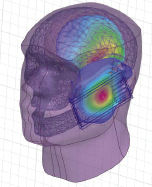 In another consulting project, Ozen was asked to simulate induced specific absorption rate (SAR) levels for a typical cell phone on the human face, skull and brain. SAR is defined by the FCC as being a “measure of the amount of radio frequency energy absorbed by the body when using a mobile phone.” |
Mike Heskitt, COO of Altair’s ProductDesign division, reveals that his unit accounts for roughly 25% of the company’s revenues. Over time, the division’s engineers gained a reputation for being able to drastically cut down weight and mass in products. The core of their approach is Altair OptiStruct software, which can propose a lighter design that can withstand the required load and stress.
Altair knew it was taking a risk when it accepted an assignment from Airbus to redesign its wing section to make it lighter. In attempting to reduce fuel consumption and carbon dioxide emission, the aerospace and automotive industries usually look to reducing weight as one of the most effective strategies. Altair has extensive experience in automotive, but the Airbus 380 program was among its early forays into aerospace. Could they apply the same weight-reduction and topology optimization principles from automotive to aerospace and achieve the same results?
The project was “pretty severely behind schedule,” Heskitt recalls. “This was a risk for Altair, because we weren’t sure we could do it in ]Airbus’s] timeframe ]of 12 weeks].” As it turned out, they could: Altair delivered its design on time, with a 40% reduction in the wing’s weight.
But the proposed topology, with 13 ribs, was so radically different from what the aerospace industry was familiar with that it first met with skepticism.
“The design we delivered was a very nontraditional airframe,” Heskitt says. “At the time, they didn’t have the technology that would make them look at solutions in that direction.”
If engineers had taken the traditional approach of padding more materials to stiffen areas expected to buckle, he explains, they would not have stumbled on the topology proposed by OptiStruct. The software examines simulation results, then proposes the optimal topology that can counteract the stress distribution—a more sophisticated approach to design.
Airbus became convinced of the integrity of Altair’s proposal when the design passed through its test program. With the new wing ribs, each Airbus aircraft is approximately 1,100 lbs. lighter. Today, Airbus maintains an optimization center in partnership with Altair.
Process Reengineering
As a PTC software reseller, EAC has access to the latest product development and data management technologies. But EAC’s Huey is no longer surprised when he meets clients using 20-year-old software, dating back to Bill Clinton’s presidency. Such aging technologies are stumbling blocks in deploying the most advanced design and engineering methods into the client’s assemblies, or efficiently tracking the revisions and versions of external references embedded within the models, he noted.
As PTC Windchill became standard PLM product for its customers, PTC phased out an older product, Pro/PDM, in 2001. As recently as last year, Huey encountered several clients still plodding along Pro/PDM’s decade-old setup. Somehow, he suspects, they won’t be the last ones he encounters.
“]These customers] were managing current-day projects with current-day design complexities in Pro/PDM,” he says. “When you’re working with a technology that old, there are severe limitations on what you can do with your design environment, because the data management system may not understand the design techniques you are trying to utilize.”
When asked why they insist on putting up with such inefficiencies, Huey’s clients often reply, “It was working for us at the time”, or “Our processes were developed around that ]old data management system].”
Sometimes Huey’s staff gets calls from those who wish to add additional functionality to their current PLM environment, data indexing or model publishing. Sometimes he gets calls to help facilitate a software replacement or to develop better data transfer between PLM systems and enterprise resource planning (ERP)/manufacturing resource planning systems. But most often, Huey gets a call when a business wants to roll out the latest version of their existing PLM software or decides to move from homegrown, directory-driven data management system to a more formal PDM or PLM system.
Huey attributes EAC’s success to the companys ability to show tangible, measurable results or improvements. “There’s a reason a customer is needing to improve or update their environment,” he said. “There should be a return on their investment. We’ll work with the customer to define these measures or metrics. After an implementation is complete, we come back and measure the results to ensure the customer is getting the value we promised.”
For example, the basic unit of measurement for a successful implementation could be the decrease in the amount of time employees spent searching for information. Another measurement may be the reduction of scrap, or wasted material, an outcome directly linked to better change control, version control, and communications with supply chain.
Successful Consultancy
EAC’s Huey admits that some of his consulting projects are hampered by clients who are slow to acquire necessary hardware—multicore workstations for graphics-heavy engineering programs, servers for data warehousing, and so on—to support the implementation. It’s not always frugality or budget constraints that prevent clients from moving to a more modern data-management environment. Sometimes it’s their unwillingness to make drastic changes to a familiar workflow and process.
Being outsiders, consultants can bring a fresh perspective to the problem a business is trying to solve. As shown in Altair’s case, they sometimes introduce innovative ideas, inspired by a different industry with which they have had the chance to study and work.
“Companies that are willing to look outside, are willing to see what other people are doing and to adopt what they can benefit from—we have the best engagement with these types of companies,” says Altair’s Heskitt. “We may see something in automotive that’s interesting, and propose that to an aerospace company to try out. But some closed-minded companies won’t see that as a value; they may only see risk.”
CD-adapco’s Marinaccio says he believes bidirectional transparency between the client and consultant is part of his team’s success formula. “We work in virtual hallways,” he quips. “As we get close to a deadline, we may be exchanging emails 20 times a day. We don’t guard our methods. Some consultants worry that if they tell the client how they do things, then they won’t be needed anymore. From our point of view, that’s a bad way to work. If they want to do something themselves, we’ll help them do that, because we’ll end up with a software sale. We’re very open to customers’ questions about what we’re doing.”
The rise of consultants in design and engineering projects has to do with the highly specialized skills freelancers can bring. For most manufacturers, CFD simulation, sustainability, electromagnetic fields, or systems integration is not their core business. Developing in-house talent to address occasional needs doesn’t seem like a pragmatic approach. For such situations, an on-demand talent pool is a more attractive alternative. But what begins as a one-time or temporary engagement may lead to a mutually benefitting relationship—turning consultant and client into partners to jointly pursue new ventures together. DE
Kenneth Wong is Desktop Engineering’s resident blogger and senior editor. Email him at [email protected] or share your thoughts on this article at deskeng.com/facebook.
MORE INFO
Subscribe to our FREE magazine, FREE email newsletters or both!
Latest News
About the Author
Kenneth Wong is Digital Engineering’s resident blogger and senior editor. Email him at [email protected] or share your thoughts on this article at digitaleng.news/facebook.
Follow DE





